国际结算 第四章 托收(Collection)
- 格式:ppt
- 大小:268.00 KB
- 文档页数:62
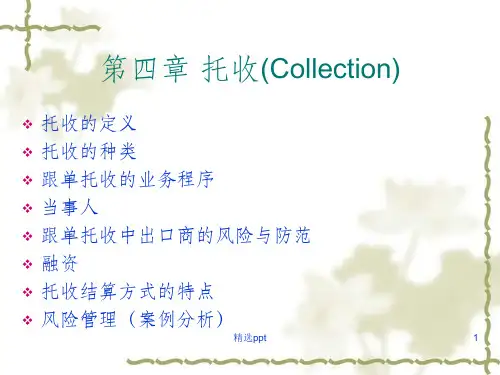

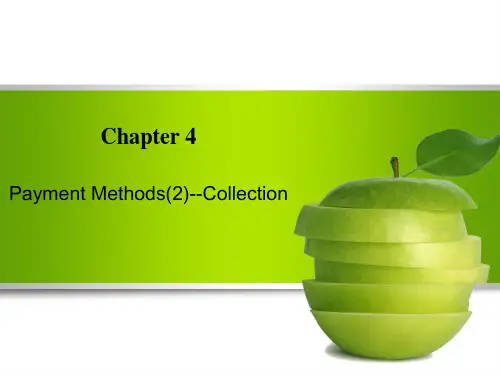
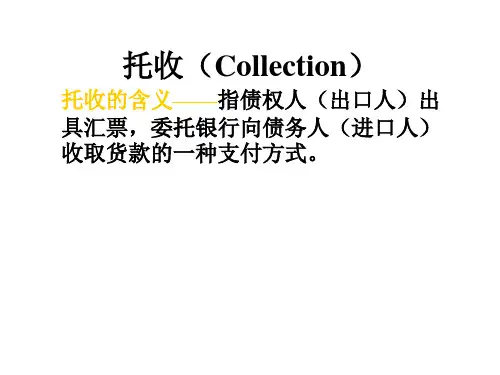

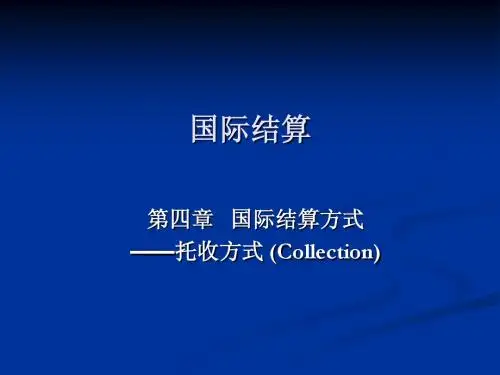
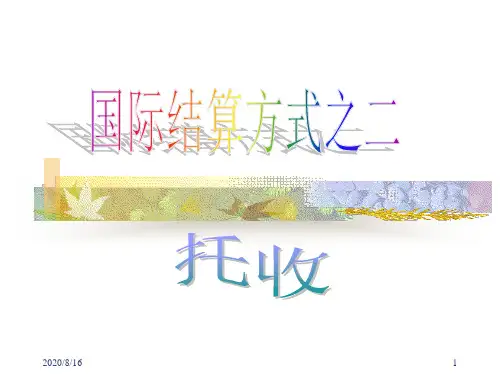

第四章托收上课材料CollectionAfter issuing payment order (draft) to importer, exporter would entrust banks with payments collection. Banks handle the business on the basis of exporter’s instruction and is not liable for the consequence of the collection, though with endeavor. Thus, bank collection is classified into commercial credit instead of bank credit.In bank collection, exporter is, to some degree, in a positive position; not releasing transportation documents( title to goods) to importer until the latter pays or accept the time draft issued by exporter, without which importer could not take delivery from carrier.Exporter is also confronted with many risks, e.g. importer might not take up transportation documents (giving up the deal) and exporter has to ship back the exports, thus entailing additional shipping and insurance costs. Or, after accepting and taking hold of the documents, importer would refuse to pay at maturity. Banks are not responsible for these breaches. So, it is commercial credit, not bank credit and is applied only when both sides know well about and have enough faith in each other. Its advantage is that collection fees earned by banks are relatively low.1、DefinitionAn arrangement whereby the goods are shipped and a relevant bill of exchange is drawn by seller on buyer, and/or shipping documents are forwarded to seller’s bank with clear instructions for collection through one of its correspondent bank located in the domicile of buyer.2、Parties to collection operationPrincipal = exporter = seller = drawer =remitterRemitting bank = exporter’s bank in exporting countryCollecting bank = importer’s bank in importing countryImporter = buyer = draweePresenting bank = bank at importer’s place3、Flow chart of Documentary Collection①Deliver goods②B/L③Documents and Instructions (Application)④Rept.⑤Collection Order or Instruction & docs.⑥Present⑦Pay⑧Release Documents D/A or D/P⑨Credit Advice or Debit Authorization⑩Hand in B/L((11))Deliver goods4、Delivering documents = Delivering goodsBuyer must take delivery of goods with bill of Lading (B/L), which is receipt issued by carrier when receiving goods delivered by seller for transportation. Importer must take delivery of goods against it. Without B/L, buyer could not get the goods at the carrier. For sight payment, only when buyer pay the sight draft drawn by seller would collecting bank release documents(B/L) to buyer. For time bill, only when buyer accepts time draft drawn by seller would collecting bank release documents to importer.(1)Documents against documents D/A①Time draft &other docs+application②Collection order& time draft & docs③Present time draft for acceptance④Accepted draft⑤docs= goods(The risk is that buyer would not pay after taking the goods,thoughgoods have been taken away.)⑥Present accepted draft for payment(Collecting bank keeps accepteddraft for exporter and at maturity, presents it for payment.)⑦pay(2)Document against payment D/P at sight①Sight draft& other docs,etc②Collection Order & sight Draft and docs③Presents for payment (Only one presentment for payment )(So, it is demanded that payment must be made on first presentation.)④Pay after checking (Importer would try to delay payment to wait the arrival of goods ) ⑤docs(3)Documents against payment at tenor D/P at tenor①Time draft & other docs ,application ②Collection order& time draft and other docs ③Present time draft for acceptance ④No docs after acceptance⑤pay (After payment at maturity, buyer gets documents.) ⑥docs(4)Documents against time promissory note made by buyer①Apply Docs.②Collection order & docs demanding time promissory note made by buyer(The risk is that buyer would not pay after taking the goods.)③Advise and demanding documents against time promissory note made by importer.④Time promissory note⑤docs⑥(Collecting bank keeps promissory note for seller and at maturity, presents it for payment.)Present timePromissory Note for payment⑦pay5、Presenting bank①ion&documents②Collection order&documents③Forwarddocuments④present6、In case of needCase of need might be seller’s close friend or agency in importing country, who would arrangeshipping back the goods or selling the goods to other buyer in importing country.①Documents (Application)②Collection Order and documents(In case of need, look for XXX)③present④refuse⑤present⑥Pay & take over docs.Exporter might have mentioned “case of need”on the draft when issuing it if exporter expects the possibility of importer’s dishonor.7、Types of collection(1): Documentary Collection①Deliver goods②B/L③Commercial docs+ financial Instrument OR not+ Application④Collection Order & docs,esp. transporting documents + bill of exchange or not⑤D/A or D/P ⑤present⑥Pay⑦Hand in B/L⑧Deliver goodsDocuments are released to importer against his payment or acceptance/Sometimes, importer pays against commercial documents, e.g. commercial invoice without financial draft to avoid stamp duty. (2): Clean Collection①Send sample ②Rept.③Delivery advice(①,②, ③,Post receipt is sent to buyer’s country together with sample by post office.) ④Hand in Delivery adv.⑤sample (④,⑤, Importer takes the advice to post office and get sample against it.) ⑥Only draft+Application⑦Collection Order& draft (Payment must be made through bank ) ⑧Present draft ⑨PayDividend warrant and time promissory note can also be used in clean collection (3): Direct Collection①Sign long terms contract with bank (Omit a tache, save much time )②Prenumbered presigned collection order③Deliver goods④B/L⑤Fill in collection order and forward documents and collection order directly to(As if it is sent by remitting bank whose responsibility is the same as under documentary collection.)⑥D/A or D/P (⑥present)⑦Pay⑧Hand in B/L⑨Deliver goods8、Collection order = Collection Instruction①Application filled in by exporter②Collection Order filled in by remitting bank[①, ②They are the same in contents, for remitting bank carry out order given by exporter (principal).]Specimen of collection orderPlease Collect the Under-mentioned Foreign Bill and /or Documents①Draft &other docs②Collection order& time draft & docs (Banks endeavor to collect for principals, but not responsible for unfavorable results.)③pay④docs(2)Bank’s responsibility①Banks must act upon the instructions given by principals②Banks check the documents received against order to see if there is any missingThe principal must be informed of any documents missing.③Banks are not responsible for examining the contents of documents, e.g. any discrepancies between docs.Sight bill: presentation for paymentTime bill: presentation for acceptance, then, presentation for payment10、Risks for exporter(1)Risks for exporter under documentary collection①Refuse to pay or accept time draft on some small inadvertent infraction of the sales contract.②Demand deep cut down of price, or refuse to accept the goods.③A heavy storage charge, fire insurance, demurrage and great expenses and time delay if court action is taken.(2)Risks for exporter under term payment①At the maturity of draft, importer refuses to pay②The excuse might be defective quality and ask for cut down of price or not having foreign exchange approved by authority.(3)Summary of possible reasons for dishonor①Economic reasons:e.g. defective quality of goods, short of flowing capital, downturn ofmarket, bankruptcy of importer,etc.②Political reasons: war, turbulence, foreign exchange control, having not got import license,etc.③The credit risk of importer (fraud) etc.(4)Protection for exporter ——Credit investigationFinancial credit and operational style of importerMarket trend of importing countryWhether import license or foreign exchange has been approved by relative authority.Whether political situation in importing country is steadyWhether a case of need could be found once dishonor happens, who could help handle returned goods, e.gwarehousing and insuring the goods, arranging shipmentof returned goods, finding another buyer for exporter, etc.Exporter could find an agency (usu.banks) to aid the investigation.To buy export credit insurance at government agency(e.g. import/export bank).Have direct control over documents, esp. the transporting documents,e.g. the consignee should be “to t he order of shipper, or collecting bank (with consent of collecting bank)”, which could be endorsed to importer only when payment is made.If it is non-negotiable transport document (e.g. airway bill), collecting bank should be the consignee who could issue delivery order to importer after the payment.(5)Example, Hedging OperationOn July 20,2000 an I/E corporation of China expected to receive €200 millions in 3 months and the spot rate of €is RMB7.6450, and 3-month forward rate is 7.6250 ~ 7.6630. As €has been weak against USD, to protect against the risk of €’s devaluation, the corporation signed a 3-month forward contract with Bank of China. After July 20, €devalued from USD0.91 all the way to USD 0.83. On Oct. 23, when the settlement was made € depreciated to RMB6.9570.Question: If the corporation was not engaged inhedging operation, how much loss would it suffer? And what is the percentage of the loss to the total amount of the contract?Answer :11、(1)Risks for importer under collection①Might be fraudulent documents.②Might be defective or dummy or not the model ordered by importer③Late shipment,and miss the optimal selling seasons.④In advance payment , can not inspect goods beforehand.⑤Dishonor would ruin importer’s reputation.(2)Protection for importerInvestigate exporter’s reputation and deal only with Credit worthy exporters.If it is time payment, payment time can be XX days/months after Bill of Lading date, which means that earlier delivery,earlier payment.Choose the most the favorable procedure of documents delivery basing on the credit standing, financial capability, market trend.e.g. if price is going high, use D/P. If price is going down,use D/A.Use D/P at tenor as possible as you can to confirm if goodsarrive at the harbor of your country.12、(1)Bill purchased under Documentary CollectionBank’s financing to exporterThere is no payment guarantee from collecting bank. So, remitting bank provide the service only for credit worthy client s.①Sight or time bill & full set of original Bill of Lading and apply for discounting the bill. ②Discounted amount③Collection Order & docs④Credit Advice or Debit Authorization ⑤Docs ⑥Pay ⑦Present(2)Discounting bill under documentary collectionThe payee on the draft is normally the discounting bank,e.g.13、Trust Receipt under D/P at tenor (1)This is Bank’s financingto importer①Time draft& other docs②Collection order & time draft and other docs ③Present time draft for acceptance ④Acceptance& IOU=T/R ⑤docs(④, ⑤ Importer borrows B/L and other documents by writing a Trust Receipt (T/R),usu. with permission of exporter.)⑥Accepted Bill &T/R ⑦pay(⑥, ⑦After selling the goods importer retires the bill with the money.) (2)The obligation of trustee, explanation of some points ①Not to put the goods in pledge to other personsthat is; trustee cannot pledge the goods to other banks for credit.②To settle claims of the collecting bank before liquidation in case of the trustee ’s bankruptcy.If trustee goes bankrupt, the entrusted goods would not joint the liquidation or entruster has first lien over the entrusted goods.③Entrusted goods should be stored and booked separately from other goods and can be examined by entruster any time.④Money from sale of entrusted goods should go directly to entruster ’s account. (3)Risks for collecting bank in T/R financingTrust Receipt does not prevent trustee from selling goods to (a third party) someone who buys the goods for value and without notice of trust (the goods does not belong to trustee). If trustee runs away with the money, the entruster could not sue the third party. Laws protects the purchaser in good faith.So, entruster usu. demands that a guarantor (usu. a bank) should sign the T/R in addition to trustee ’s signature.The principal presents an application for collection accompanied by draft and documents to the remitting bank for collection.An application for collection shows as follows:Commercial documents surrendered are below:B/L in triplicate, two originals and one copyInvoice in triplicate, two originals and one copyInsurance policy in duplicate, one original and one copyCertificate of origin in duplicate, One original and one copyPacking list in duplicate, One original and one copyCollection instructions are given below:Deliver documents against paymentRemit the proceeds by airmailAirmail advice of paymentCollection charges outside China from drawee, waive if refused by him.Airmail advice of non-payment with reasonsProtest waivedWhen collected, please credit proceeds to principal’s account with remitting bank. Remitting bank complete a collection instruction in accordance with principal’s application to add other requirements as follows:Ref No. OC2576459Date: 15 July,2000Please collect and remit proceeds to Bank of China, New York for credit of our account with them under their advice to usPlease produce a collection instruction attaching draft and documents to be forwarded to the collecting bank, Banque du Paris, Paris.Collection InstructionORIGINALTO:_________________ Date:_______Our Ref. No_______Dear Sirs,Please follow instruction marked”x”□Deliver documents against payments/acceptance.□Remit the proceeds by airmail/cable.□Airmail/cable advice of payment/acceptance.□Collect charges outside_____ from drawee,waive if refuse by him.□Collect interest for delay in payment____days after sight at____% per annum.□Airmail/cable advice of non-payment/non-acceptance with reasons.□Protest for non-payment/non-acceptance.□Protest waived.□When accepted, please advise us giving due date.□When collected, please credit our account with___.□Please collect and remit proceeds to ____for credit of our account with them under their advice to us. □Please collect proceeds and authorize us by airmail/cable to debit your account with us.Special InstructionsThis collection is subject to Uniform Rules for collection(1995 Revision) ICC Publication No.522Authorized signature(s)TRUST RECEIPTTO:__________ ________,________Received from the said bank a full set of shipping document evidencing the merchandise having an invoice value of______say______ as follows:And in consideration of such delivery in trust ,the undersigned hereby undertakes to land, pay customs duty and/or other charges or expenses ,store, hold and sell and deliver to purchasers the merchandise specified herein ,and to receive the proceeds as trustee for the said bank , and the undersigned promises and agrees not to sell the said merchandise or any part thereof on credit , but only for cash for a total amount not less than the invoice value specified above unless otherwise authorized by the said bank in writing.The undersigned further acknowledges assents and agrees that in the event the whole or any part of the merchandise specified herein is sold or delivered to a purchaser or purchaser any proceeds derived or to be derived from such sale or delivery shall be considered the property or the said bank and the undersigned hereby grants to be said bank full authority to collect such proceeds directly from the purchaser or purchaser without reference to the undersigned.The guarantor, as another undersigned, guarantees to the said bank the faith and proper fulfillment of the terms and conditions of the trust receipt.Guaranteed by: signed by:_____________ _______________________ ___________。
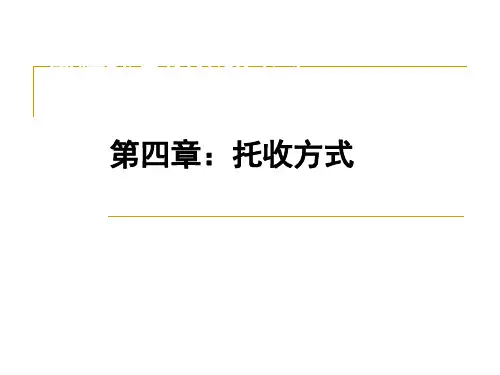
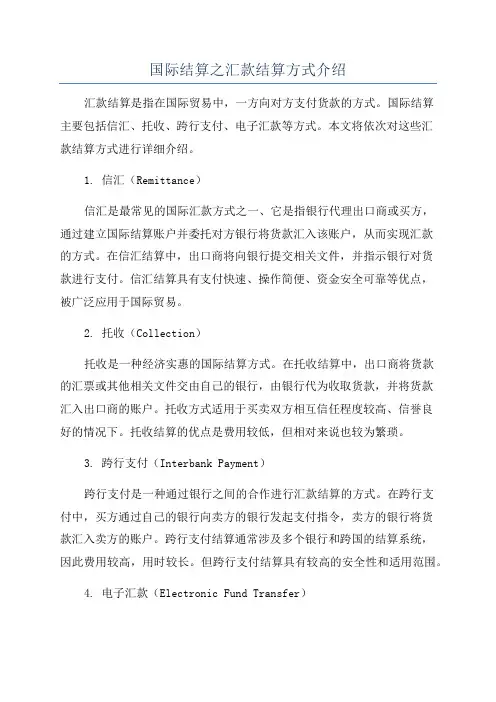
国际结算之汇款结算方式介绍汇款结算是指在国际贸易中,一方向对方支付货款的方式。
国际结算主要包括信汇、托收、跨行支付、电子汇款等方式。
本文将依次对这些汇款结算方式进行详细介绍。
1. 信汇(Remittance)信汇是最常见的国际汇款方式之一、它是指银行代理出口商或买方,通过建立国际结算账户并委托对方银行将货款汇入该账户,从而实现汇款的方式。
在信汇结算中,出口商将向银行提交相关文件,并指示银行对货款进行支付。
信汇结算具有支付快速、操作简便、资金安全可靠等优点,被广泛应用于国际贸易。
2. 托收(Collection)托收是一种经济实惠的国际结算方式。
在托收结算中,出口商将货款的汇票或其他相关文件交由自己的银行,由银行代为收取货款,并将货款汇入出口商的账户。
托收方式适用于买卖双方相互信任程度较高、信誉良好的情况下。
托收结算的优点是费用较低,但相对来说也较为繁琐。
3. 跨行支付(Interbank Payment)跨行支付是一种通过银行之间的合作进行汇款结算的方式。
在跨行支付中,买方通过自己的银行向卖方的银行发起支付指令,卖方的银行将货款汇入卖方的账户。
跨行支付结算通常涉及多个银行和跨国的结算系统,因此费用较高,用时较长。
但跨行支付结算具有较高的安全性和适用范围。
4. 电子汇款(Electronic Fund Transfer)电子汇款是一种通过电子渠道进行的实时汇款结算方式。
它基于电子数据交换和网络通讯技术,将资金从买方的账户直接转到卖方的账户。
电子汇款结算具有支付迅速、操作简便、成本低廉等优点,已成为现代国际贸易中被广泛使用的结算方式之一总之,国际结算中的汇款结算方式多种多样,每种方式都具有自身的特点和适用范围。
出口商和买方在选择合适的汇款方式时,应根据交易金额、资金安全、支付速度、手续费用等因素进行综合考虑。
此外,随着科技的进步,电子汇款等新兴结算方式将会越来越受到国际贸易主体的青睐。

读书破万卷,下笔如有神
国际结算之托收
一.托收概念
托收(COLLECTION)是出口商开立汇票,委托银行代收款项,向国外进
口商收取货款或劳务款项的一种结算方式。
二.托收当事人
托收当事人有四个,主要责任如下:
1.委托人(PRINCIPAL)
也称出票人,一般是出口商,主要是行使与进口商签订的合同上的条款,履行与银行签订的委托收款的合同。
2.寄单行(REMITTING BANK)
也称托收行,是委托代收款项的银行,主要是按照委托人的要求和国际惯例进行处理业务。
3.代收行(COLLECTING BANK)
托收行是在进口地的代理人,根据托收行的委托书向付款人收款的银行。
4.付款人(DRAWEE)
一般是进口商。
主要是支付款项的人。
三.托收方式
托收方式有:
1.跟单托收(DOCUMENTARY COLLECTION)
(1)跟单托收概念
跟单托收是汇票连同商业单据向进口行收取款项的一种托收方式,有时为了避免印花税,也有不开汇票,只拿商业单据委托银行代收。
(2)跟单托收种类
好记性不如烂笔头。